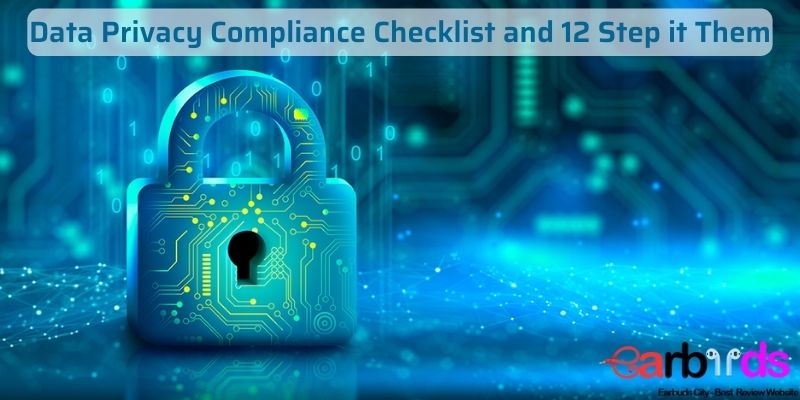What is data privacy compliance checklist? On a typical day, a considerable amount of your personal data is collected, recorded, and extracted. Trackers installed in apps collect geographical data, internet behavior, what sites interest you, and how much time you spend on them.
If you are a developing cloud-hosted firm that is unsure whether the GDPR applies to you, we have produced a GDPR needs checklist to assist you in understanding what you need to do. In this article, earbudscity.com will discuss data privacy compliance checklist.
Data Privacy Compliance Checklist and 12 Step it Them
The GDPR compliance checklist offered below can assist businesses in determining their compliance status and achieving GDPR compliance by 2023.
Raise awareness (Data privacy compliance checklist)

GDPR compliance is not restricted to top management or the DPO.
You must handle compliance work holistically, incorporating all of your staff. Raise awareness about data security and protection to instill a sense of responsibility.
- Begin by identifying areas that potentially lead to GDPR noncompliance, such as your company’s risk register.
- Provide physical security for employee-carried devices and the office.
- Control employee data access to limit the number of exit points.
Inquire about the GDPR compliance of your third-party suppliers and subcontractors. If they are not, you are also not in compliance. Either propose that they work toward compliance or switch business partners.
To be entirely compliant, you should also have data processing agreements (rather than merely verbal or written confirmation) with third-party vendors.
Keep a record of data processing flows (Data privacy compliance checklist)
You must understand how your clients’ data goes in and out of your cloud-hosted business. By keeping such records for each piece of data, you may comply with GDPR’s accountability principle, which requires businesses to be able to demonstrate the efforts they’re taking to comply with data protection rules.
Make a note of the following details:
- What are the departments in your company?
- What kinds of personal data are kept in each department?
- How does each department process personal data?
- Who is in charge of data processing in each department?
Compile the information into a logical document and keep it up to date with your data handling practices.
If you have shared erroneous personal information with another company, you must contact that company so that its records can be corrected.
Review current privacy notices (Data privacy compliance checklist)

Individuals must be given more information about their personal data under the GDPR. Previously, you were required to notify people of your identity and how you intended to use the data.
You must now change the content of your privacy policy to incorporate the following in simple and unambiguous language:
- How are you gathering the personal data?
- Why are you collecting personal information (legal basis)?
- What are your plans regarding the personal data?
- How long will you hold the personal data?
- What are the rights of your users? (If they are dissatisfied with your data processing, they can register a complaint with the ICO.)
Create a detailed cookie policy that explains which cookies are active on your website and what they are used for. To keep your cookie policy up to date, use automated cookie tools to conduct audits and generate declarations.
Check your rights for individuals (Data privacy compliance checklist)
Examine your privacy and/or data protection procedures and policies to check that they meet the GDPR’s requirements for addressing individuals’ rights. This includes information on how you plan to destroy personal data and whether you may provide the data electronically in a generally used format for free.
Individuals will have expanded rights under the GDPR to:
- access their information
- have mistakes corrected
- data portability
- have personal data deleted
- prevent direct marketing
- prevent automated decision-making and profiling
Determine how your organization would respond if a person requests that their personal data be destroyed, for example. Can you find and erase data on your systems? Who will make decisions based on data?
Review and update procedures for submitting requests (Data privacy compliance checklist)
Examine and improve your present procedures to handle subject access requests (SAR) in a timely and effective manner.
Create a strategy for dealing with requests in light of the new rules:
- In most cases, you will not be able to charge a fee for fulfilling a request.
- You must comply with SARs within one month, rather than the previously permitted timeframe of 40 days.
- You have the right to decline a request that you believe is excessive or clearly unfounded.
- If you decline a request, you must explain why and inform the subject that they have the right to file a complaint with the supervisory body and take legal action. You must also complete this within one month and without unnecessary delay.
Consider if your organization, especially if it is large, can manage a large number of SARs within the required timeframes. Can you provide more details, such as data retention periods and the correction of mistakes in your present systems?
Some practical steps you can take:
- To guarantee that SARs are correctly addressed, create GDPR-compliant response letters.
- Update SAR rules and processes to reflect increased individual rights, new timeframes, and the elimination of the cost for complying with requests.
- Create technical mechanisms to process personal data rapidly and in the format necessary.
- Create new policies to swiftly address data inconsistencies and a procedure to halt processing where appropriate.
Identify, record, and explain the legitimate basis (Data privacy compliance checklist)
Examine your cloud-hosted company’s data processing activities and determine the legal foundation for them. Document the change and clearly amend your privacy notice to reflect it. When responding to SARs, you must additionally explain your legal grounds.
Identifying your lawful basis for data processing is critical under the GDPR because it affects some individuals’ rights. People will have a stronger right to have their data removed if you declare your lawful basis as permission, for example.
Update existing consent (Data privacy compliance checklist)
The GDPR requires cloud-hosted enterprises, like cookie policies, to update their cookie consent banners in simple, easy-to-understand English that is succinct and explicit.
It should include an opt-out button for those who do not wish to provide their consent. Cookie software can generate personalized user consents for you.
Examine any additional methods of gaining consent and obtain new consent if your current ones are not GDPR-compliant.
Protect children’s data (Data privacy compliance checklist)

Consider whether you need to put mechanisms in place to verify individuals’ ages and acquire parental/guardian consent when processing children’s data.
In the context of commercial internet services such as social networking, the GDPR has introduced extra protection for vulnerable data subjects, particularly minors.
You must seek the approval of a parent or guardian if your cloud-hosted company delivers “information society services” to children that require consent for personal data gathering. This consent must be verifiable and given in terms that children understand.
Children under the age of 16 (13 in the United Kingdom) require such consent from someone with “parental responsibility.”
Detect, report, and investigate data breaches (Data privacy compliance checklist)
Put in place the proper procedures for detecting, reporting, and investigating a personal data breach. Conduct a GDPR assessment to discover the sorts of data you have and which will require notification in the event of a breach.
The GDPR requires all cloud-hosted enterprises to notify the ICO and, in some situations, individuals of certain types of data breaches.
For example, the breach is likely to jeopardize individuals’ rights and freedoms and may result in financial loss, reputational harm, loss of confidentially, or discrimination.
When you become aware of a personal data breach, you must notify the appropriate supervisory authority within 72 hours. Individuals should be informed as soon as possible if their rights and freedoms are jeopardized.
Adopt a privacy and data-protection mindset (Data privacy compliance checklist)
Cloud-hosted companies should adopt “privacy by design.”
- In high-risk instances, such as when a profiling exercise may have an impact on users or when a new technology is introduced, do a Data Protection Impact Assessment (DIPA).
- Encrypt data using either pseudonymization or anonymization, as recommended by the GDPR.
- To limit the volume of data that needs to be protected, delete data that you are no longer using or that is no longer required. Remove obsolete data from backups as well.
- Ensure that your data centers are located in high-security areas, such as the United States or Europe.
- Implement IT measures such as employee double authentication and TLS/SSL certifications.
- Encrypt your system passwords and secure the devices that employees bring to work.
- Conduct regular vulnerability assessments on devices, systems, and networks to identify potential security flaws.
Assign a Data Protection Officer (DPO) (Data privacy compliance checklist)
Determine and appoint a Data Protection Officer (DPO) to be in charge of data protection compliance. Determine how this position will fit within your organization’s structure and governance structures. Consider whether you must formally appoint a DPO.
According to the GDPR, you must appoint a DPO in the following circumstances:
- You are a public authority
- Your firm or you monitor significant amounts of data on a regular and methodical basis.
- You process special types of data on a huge scale, such as health records or data regarding criminal convictions. The Article 29 Working Party advises businesses on the designation, role, and responsibilities of the DPO.
Points (2) and (3) apply to the majority of cloud-hosted businesses because personal data processing and data monitoring are critical activities for them. To be GDPR-compliant, they must engage a DPO (internal/external consultant).
An internally appointed DPO may require some training to comprehend the GDPR and the role’s obligations.
Choose your lead authority (Data privacy compliance checklist)
If your cloud-hosted company operates in more than one EU member state, or if you have a single EU facility that does processing affecting EU people in additional EU member states, you should select and document a lead data protection supervisory authority. Refer to the Article 29 Working Party’s guidelines.
You can identify your “main establishment” by mapping the locations where your organization makes the most important decisions regarding its data processing activities. This establishment’s supervisory authority will be the main authority.
Companies situated outside the EU must comply with GDPR standards if they provide services to EU individuals or monitor activity within the European Union.

